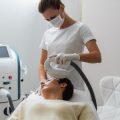Introduction to Laser Treatments in Ethnic Skin
The world of aesthetic dermatology has made remarkable strides in recent years, particularly when it comes to laser treatments for ethnic skin types. Historically, individuals with darker complexions—ranging from Asian and African to Middle Eastern backgrounds—have faced unique challenges and risks when seeking laser-based procedures. In the UK, a wonderfully diverse society, these concerns are far from rare. Many people with Fitzpatrick skin types IV to VI have long hesitated to explore laser treatments due to stories of hyperpigmentation, scarring, or uneven results. This caution is not unfounded; older generation lasers were primarily designed and tested on lighter skin tones, often overlooking the nuances that darker skin presents.
With the growing demand for safe and effective treatments among British residents of all backgrounds, the importance of bespoke solutions cannot be overstated. Personal experience has shown me that ‘one-size-fits-all’ simply doesn’t apply here. The UK’s multicultural tapestry necessitates a more thoughtful approach—one that acknowledges not only the technical aspects but also the lived experiences and aesthetic goals of those with ethnic skin. As technology advances, so too does our ability to provide gentle yet transformative care, ensuring both safety and satisfaction for everyone who wishes to embrace laser treatments as part of their beauty journey.
2. Technological Breakthroughs Enhancing Safety
As the landscape of dermatological care in the UK becomes increasingly diverse, the demand for laser technologies that cater to a wide spectrum of skin tones has grown significantly. Recent advancements in laser technology are not just about efficacy; they are fundamentally reshaping how British practitioners approach safety, especially for ethnic skin types that historically faced higher risks of side effects such as hyperpigmentation or scarring.
Precision-Driven Innovations
The latest generation of lasers, including picosecond and nanosecond devices, deliver energy in ultra-short pulses. This precision minimises thermal damage to surrounding tissues, a crucial consideration for darker skin tones where melanin content is higher. These innovations allow for targeted treatment—whether it’s pigmentation, hair removal, or rejuvenation—while dramatically reducing the risk of post-inflammatory responses.
Key Features Tailored for Ethnic Skin
| Technology | Main Benefit | Impact on Safety |
|---|---|---|
| PicoSure/Picoway Lasers | Ultra-short pulse duration | Minimises heat spread, less risk of pigmentation changes |
| Long-Pulsed Nd:YAG (1064nm) | Deeper penetration, low melanin absorption | Safe for darker skin, reduced risk of burns |
| Fractional Laser Systems | Treats tiny fractions of skin at a time | Promotes faster healing and lower complication rates |
| Dynamic Cooling Devices (DCD) | Cools skin before each laser pulse | Provides added protection for sensitive or richly pigmented skin |
The British Approach: Customisation and Consultation
In UK clinics, there is an increasing emphasis on pre-treatment consultation and patch testing—now considered gold-standard practice. These steps are critical in identifying individual sensitivities and tailoring settings accordingly. What’s more, many clinics are investing in staff training programmes focused on recognising the subtleties of ethnic skin physiology, ensuring technology is matched with expertise.
A Glimpse into the Future of Dermatology in Britain
The integration of these technological breakthroughs is transforming patient experiences across the country. With each innovation, British dermatology moves closer to an era where safe, effective laser treatments are truly inclusive—reflecting both clinical excellence and a respect for Britain’s multicultural tapestry.
![]()
3. Tailoring Laser Procedures for Multicultural Britain
Living and practising in the UK, one quickly recognises the vibrancy and diversity of our population—a true multicultural tapestry. When it comes to laser procedures, this diversity means that a ‘one-size-fits-all’ approach simply won’t do. Recent advances in laser technology have empowered clinicians to adopt more personalised strategies, starting with thorough skin assessment protocols. These assessments go beyond the basic Fitzpatrick scale, taking into account subtle variations in skin tone, genetic background, and even lifestyle factors unique to each patient.
The choice of device is also crucial. Modern clinics now have access to a range of cutting-edge lasers, from Nd:YAG to picosecond systems, specifically designed for safer use on darker skin tones. These devices allow for precise targeting of concerns like pigmentation or unwanted hair, while minimising risks such as hyperpigmentation or scarring—a common worry among patients with ethnic skin types.
Equally important is practitioner expertise. British clinics are increasingly offering training focused on treating diverse skin tones, ensuring not only technical proficiency but also cultural sensitivity. This holistic approach resonates deeply with patients who seek reassurance that their individual needs are genuinely understood and respected.
By combining advanced technology with personalised care and an awareness of Britain’s multicultural landscape, practitioners can deliver superior results—helping everyone feel confident in their own skin.
4. Minimising Risks: Evidence-Based Guidelines
The landscape of laser treatments for ethnic skin has evolved considerably, with UK-based specialists now placing strong emphasis on minimising risks such as post-inflammatory hyperpigmentation (PIH) and scarring. Updated clinical guidelines reflect both rigorous scientific evidence and practical experience gained within diverse communities across the UK.
Key Recommendations from Recent Clinical Guidelines
| Guideline | Clinical Rationale | Practical Tip |
|---|---|---|
| Laser Selection | Preference for longer wavelength lasers (e.g., Nd:YAG 1064nm) due to deeper penetration and reduced melanin absorption | Choose devices with proven safety data in Fitzpatrick skin types IV-VI |
| Test Patching | Essential to assess individual response and reduce risk of adverse outcomes | Always perform test patches on a less visible area before full treatment |
| Energy Settings | Start with lower fluence and gradually titrate based on patient tolerance and results | Avoid aggressive settings, especially during initial sessions |
| Epidermal Cooling | Cools the skin surface, protecting melanocytes and reducing PIH risk | Utilise contact cooling or cryogen spray during procedures |
| Pre- and Post-care Regimens | Reduces inflammation and supports optimal healing, further minimising complications | Recommend sunscreen, gentle cleansers, and avoid irritants post-procedure |
Navigating Real-World Scenarios: Insights from UK Specialists
UK practitioners highlight the importance of culturally sensitive consultations and realistic expectation-setting. Many patients from ethnic backgrounds may have heightened anxiety about pigmentation changes; addressing these concerns through clear communication is vital. Additionally, local specialists often recommend scheduling treatments outside of peak summer months to further lower PIH risk, given the unpredictability of British weather.
Case Study: Practical Pearls from a London Dermatology Clinic
A consultant dermatologist in London shared that combining pre-treatment topical agents such as hydroquinone or azelaic acid can prime the skin, while close follow-up enables early intervention should any pigmentation changes occur. The clinic’s stepwise protocol—test patching, conservative energy settings, robust aftercare—has significantly reduced complication rates among their ethnically diverse clientele.
The Takeaway: Safety Through Tailored Protocols and Shared Expertise
The current consensus in the UK is clear: meticulous technique, device selection tailored to skin type, and ongoing education are paramount. By embracing evidence-based guidelines and sharing real-world tips, practitioners are creating safer, more inclusive experiences for all patients seeking laser treatments.
5. Patient Experience: Stories from Across the UK
One of the most inspiring aspects of recent advances in laser technology is hearing directly from patients whose lives have been transformed. Across the UK, individuals from a diverse range of ethnic backgrounds are sharing stories of increased confidence and comfort thanks to treatments that are safer and more effective than ever before.
Aisha’s Journey: Finding Confidence in Manchester
Aisha, a young professional from Manchester with South Asian heritage, always felt self-conscious about pigmentation on her cheeks. Traditional laser treatments weren’t an option due to safety concerns for her skin type. However, after consulting with a local clinic that recently adopted advanced picosecond lasers designed specifically for ethnic skin, she decided to give it a try. “I was amazed by how gentle the treatment felt,” she recalls. “Within weeks, my pigmentation faded noticeably and I didn’t experience any scarring or prolonged redness.” For Aisha, these advances meant reclaiming her natural glow without fear.
Kwame’s Story: Safe Solutions in London
Kwame, who lives in South London, struggled with razor bumps and uneven texture due to years of shaving. As a Black man, he was wary of older laser technologies that often led to burns or hyperpigmentation. When his dermatologist recommended the latest Nd:YAG laser system—specifically calibrated for deeper skin tones—he felt hopeful. “The results were incredible,” Kwame shares. “Not only did my skin clear up, but the process was comfortable and I felt truly seen as a patient.”
Sara’s Perspective: Embracing Change in Edinburgh
Sara moved to Edinburgh from the Middle East and faced sun spots that made her feel less confident. She found a clinic specialising in treatments for ethnic skin using new fractional lasers. The careful assessment and bespoke approach gave her peace of mind. “It was reassuring to know the staff understood how my skin would react,” Sara explains. “After just two sessions, my complexion looked brighter and more even.”
Real Impact Beyond Results
These accounts highlight not just physical improvements but also emotional well-being. Patients consistently mention feeling respected and listened to throughout their journeys—a testament to clinics embracing both technological innovation and cultural sensitivity.
The Future Looks Bright
With every story shared across the UK, it’s clear that newer laser technologies are bridging gaps in care for ethnic skin. As these advancements become more widely available, even more people can look forward to safe treatments tailored just for them—unlocking beauty and confidence previously out of reach.
6. The Future of Laser Safety for Ethnic Skin
As we look to the future, the landscape of laser technology in British dermatology is set to evolve at a remarkable pace, especially regarding the safety and efficacy of treatments for ethnic skin. Emerging trends suggest a strong movement towards personalisation, with next-generation devices becoming increasingly adaptable to the unique characteristics of Fitzpatrick skin types IV to VI. Key research centres across the UK are collaborating with international experts to pioneer studies on wavelength optimisation, fractional delivery systems, and real-time feedback mechanisms that dramatically reduce adverse effects such as post-inflammatory hyperpigmentation.
Moreover, artificial intelligence is starting to play a role in both diagnosis and treatment planning. Algorithms trained on diverse datasets—reflecting Britain’s multicultural reality—promise more accurate assessments and bespoke protocols that consider not only skin colour but also genetic background and cultural beauty ideals.
Cultural competence remains paramount in this context. Forward-thinking British clinics are investing in ongoing education for practitioners, ensuring sensitivity towards the aesthetic goals and concerns prevalent within ethnic communities. The future points towards multidisciplinary care teams where dermatologists, aestheticians, and patient advocates work together to foster trust and inclusivity.
Ultimately, these advances signal a new era: one where cutting-edge technology meets deep respect for diversity. As someone who cherishes both scientific progress and the beauty found in every skin tone, I am excited by how these innovations will empower patients—enabling safe, effective laser treatments that celebrate individuality while upholding the highest standards of care.


